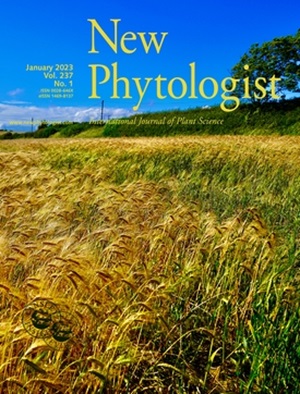Leaf nonstructural carbohydrate residence time, not concentration, correlates with leaf functional traits following the leaf economic spectrum in woody plants
IF 8.3
1区 生物学
Q1 PLANT SCIENCES
引用次数: 0
Abstract
- Nonstructural carbohydrate (NSC) concentrations might reflect the strategies described in the leaf economic spectrum (LES) due to their dependence on photosynthesis and respiration.
- We examined if NSC concentrations correlate with leaf structure, chemistry, and physiology traits for 114 species from 19 sites and 5 biomes around the globe.
- Total leaf NSC concentrations varied greatly from 16 to 199 mg g−1 dry mass and were mostly independent of leaf gas exchange and the LES traits. By contrast, leaf NSC residence time was shorter in species with higher rates of photosynthesis, following the fast-slow strategies in the LES. An average leaf held an amount of NSCs that could sustain one night of leaf respiration and could be replenished in just a few hours of photosynthesis under saturating light, indicating that most daily carbon gain is exported.
- Our results suggest that NSC export is clearly linked to the economics of return on resource investment.
求助全文
约1分钟内获得全文
求助全文
来源期刊

New Phytologist
生物-植物科学
自引率
5.30%
发文量
728
期刊介绍:
New Phytologist is an international electronic journal published 24 times a year. It is owned by the New Phytologist Foundation, a non-profit-making charitable organization dedicated to promoting plant science. The journal publishes excellent, novel, rigorous, and timely research and scholarship in plant science and its applications. The articles cover topics in five sections: Physiology & Development, Environment, Interaction, Evolution, and Transformative Plant Biotechnology. These sections encompass intracellular processes, global environmental change, and encourage cross-disciplinary approaches. The journal recognizes the use of techniques from molecular and cell biology, functional genomics, modeling, and system-based approaches in plant science. Abstracting and Indexing Information for New Phytologist includes Academic Search, AgBiotech News & Information, Agroforestry Abstracts, Biochemistry & Biophysics Citation Index, Botanical Pesticides, CAB Abstracts®, Environment Index, Global Health, and Plant Breeding Abstracts, and others.
 求助内容:
求助内容: 应助结果提醒方式:
应助结果提醒方式:


